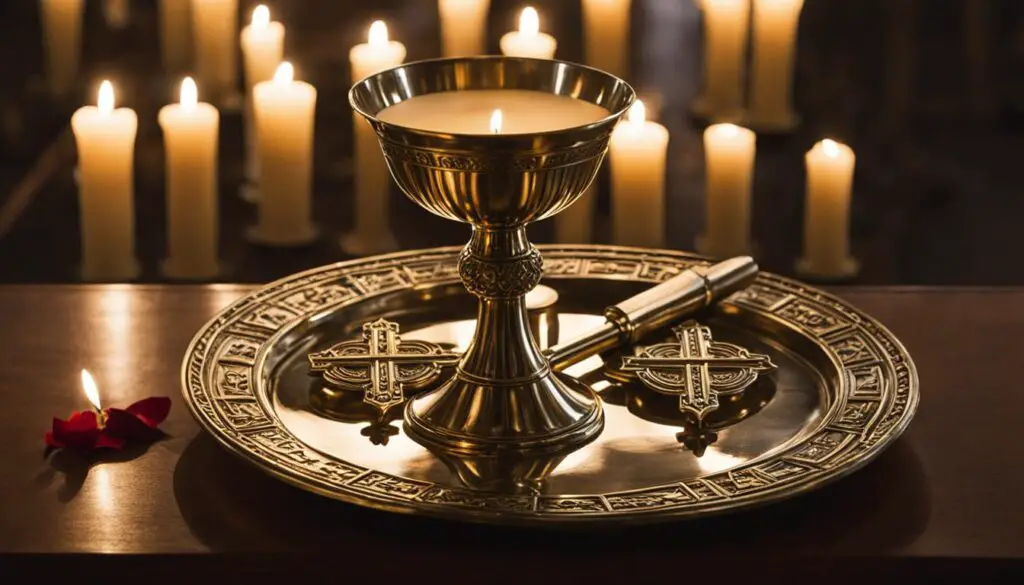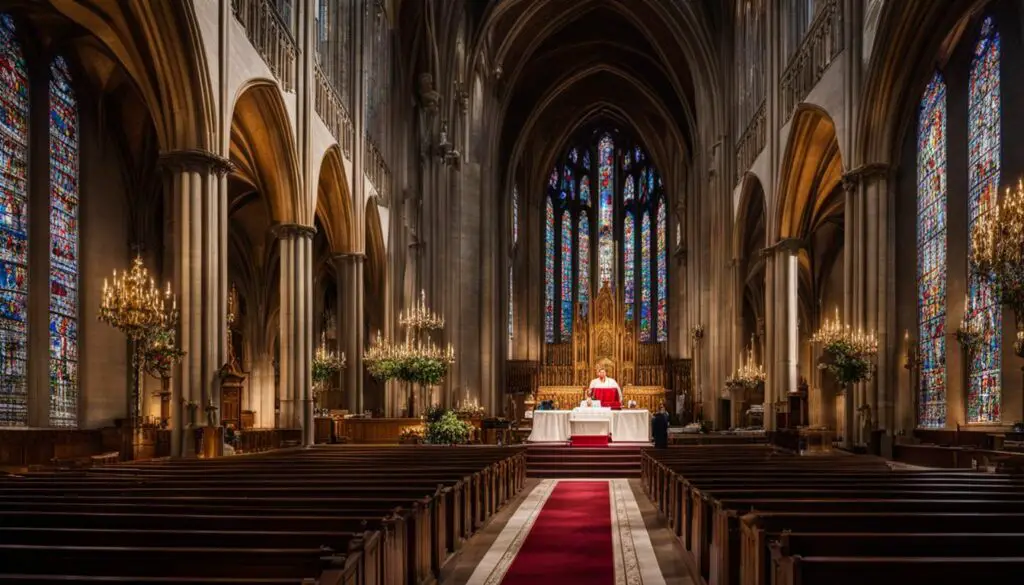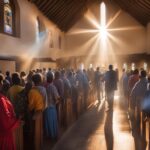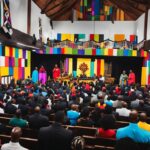In this article, we will explore the pillars of Church Government and how ecclesiastical structures shape spiritual leadership and governance within the faith community. From the history and origins of church government to the contemporary challenges faced today, we will delve into the various aspects that contribute to the intricate tapestry of church administration and management.
Church government encompasses the hierarchy, governance, and leadership structures of the church, guiding its operations and decision-making processes. At the heart of it all lies the commitment to uphold and practice the beliefs, doctrines, and rituals that define a religious community.
Throughout history, church government has evolved, adapting to cultural, societal, and theological changes. Different denominations and sects have developed their own unique systems of governance, reflecting their interpretations and convictions.
Key components of church government include the sacraments and rituals that propel the spiritual life of the community, the leadership and clergy who guide and nurture its members, the worship practices that forge communal identity and connection with the divine, and the sacred texts that serve as a foundation for faith and practice.
Furthermore, the architectural and artistic features of church structures provide physical embodiments of spiritual values and beliefs, reflecting the aesthetic and cultural influences of the time and place.
Today, church government faces modern challenges and issues to address, including leadership succession, adaptation to societal changes, conflicts and controversies, and the management of complex administrative tasks.
Key Takeaways:
- Church government encompasses the hierarchy, governance, and leadership structures of the church.
- Beliefs, doctrines, and rituals shape the system of church government.
- Sacraments and rituals play a significant role in spiritual growth and community building.
- Leadership and clergy are vital in guiding and nurturing the faith community.
- Worship practices form a central part of church governance, reflecting theological emphases and cultural contexts.
History and Origins of Church Government
Church government has a rich history that traces its roots back to the early days of Christianity. The origins of church structure and the development of church governance have been shaped by cultural, theological, and societal factors throughout history.
The ecclesiastical history of church government reveals the evolution of different structures and systems of governance. From the early apostolic leadership to the emergence of hierarchical structures, the church has undergone significant changes over time.
During the first few centuries, the early Christian community operated under a decentralized model with a strong emphasis on local congregations and spiritual gifts. As the church grew and faced challenges, a more organized and centralized structure emerged. This shift was influenced by the need for unity, the rise of bishops as leaders, and the establishment of formalized church synods and councils.
One significant milestone in the history of church government is the recognition of the Bishop of Rome as the head of the Roman Catholic Church, laying the foundation for the papal authority. This development, along with the East-West Schism that divided the Church into Western (Roman Catholic) and Eastern (Eastern Orthodox) branches, shaped the ecclesiastical structures and governance models that exist today.
By understanding the historical context of church government, we gain valuable insights into the present-day models and their significance within the church. Examining the origins and historical progression helps us appreciate the diversity and complexity of church governance, fostering a deeper understanding of its role in the spiritual life of believers.

Beliefs and Doctrines Shaping Church Government
The system of church government within a religious community is deeply influenced by its beliefs and doctrines. These theological principles lay the foundation for the structure, leadership, decision-making processes, and distribution of power within the church.
Each denomination or sect upholds specific theological beliefs that shape their approach to church governance. These beliefs often stem from interpretations of sacred texts, historical traditions, and the teachings of prominent theologians.
One example of how beliefs influence church government can be seen in the different perspectives on the authority of scripture. Some denominations emphasize a literal interpretation of the Bible, considering it the ultimate source of guidance for matters of faith and practice. This belief in the authority of scripture may result in a decentralized form of governance, where local congregations have more autonomy in decision-making processes.
On the other hand, other denominations prioritize the authority of tradition and the guidance of ecclesiastical leaders alongside scripture. These beliefs often lead to hierarchical structures, where authority is centralized in a governing body or clergy.
Another aspect influenced by beliefs and doctrines is the understanding of the role and responsibilities of church leaders. Different denominations may have varying views on the ordination of women, the role of bishops, or the qualifications for clergy. These beliefs shape the selection process, roles, and authority granted to individuals within the church leadership structure.
“In the kingdom of God, servant leadership prevails. The embodiment of Christ-like humility and love forms the core of effective church governance.”
In addition to beliefs and doctrines, sacraments and rituals are also instrumental in shaping church government. The practices associated with baptism, communion, and other sacraments often have specific requirements and guidelines that impact the structure and organization of the church.
| Beliefs and Doctrines | Influence on Church Governance |
|---|---|
| Authority of Scripture | Determines the decision-making processes and the level of autonomy within the church. |
| Role of Tradition | Shapes the hierarchy and centralized authority in ecclesiastical structures. |
| Understanding of Leadership | Influences the selection process, roles, and authority granted to church leaders. |
Understanding the beliefs and doctrines that underpin a denomination or sect is essential for comprehending their approach to church governance. These theological principles guide not only the structure of the church but also its mission, values, and the way it interacts with the broader community.

Next, we will explore the role of sacraments and rituals in church government and their significance within different denominations and sects.
Sacraments and Rituals in Church Government
Sacraments and rituals hold a significant place within the framework of church governance. They serve as powerful expressions of faith, communal bonding, and avenues for spiritual growth. These deeply symbolic practices not only strengthen the connection between the individual and the divine but also shape the spiritual leadership within the ecclesiastical structures.
One of the most sacred and universally recognized sacraments in Christianity is the Eucharist or Holy Communion. This communal ritual, rooted in the Last Supper of Jesus Christ, symbolizes the unity of believers and their participation in the sacrifice and teachings of Christ. Through the sharing of bread and wine, individuals are reminded of the spiritual nourishment and grace offered by God.
Another sacrament that plays a crucial role in church governance is baptism. This ritual, often performed at infancy or adulthood, signifies the initiation into the Christian faith and the cleansing of sin. It is viewed as a unifying ceremony that welcomes individuals into the community of believers and marks the beginning of their spiritual journey.
Beyond sacraments, various rituals and practices contribute to the overall experience of church governance. These rituals can include prayer services, liturgical readings, and specific rites performed by the clergy during worship. Each denomination and sect may have its distinct set of rituals, which reflect their theological interpretations and denominational traditions.
“The sacraments and rituals within the church remind us of the rich tapestry of faith and the spiritual practices that shape our ecclesiastical structures. They invite us to engage in shared experiences, deepen our relationship with God, and form an integral part of the church governance.”
Within the Catholic Church, for example, the sacrament of confession or reconciliation is practiced, wherein individuals confess their sins to a priest and receive absolution. This ritual is seen as an opportunity for spiritual healing and personal transformation.
As we explore the sacraments and rituals within different church government structures, we gain insights into their theological underpinnings and the ways in which they shape spiritual leadership. By participating in these practices, believers affirm their commitment to the values and principles upheld by their faith community, fostering a sense of unity and shared identity.

Sacraments and Rituals Comparison
| Sacraments and Rituals | Denominations |
|---|---|
| Baptism | Catholic, Orthodox, Protestant |
| Holy Communion (Eucharist) | Catholic, Orthodox, Protestant |
| Confirmation | Catholic, Orthodox |
| Confession (Reconciliation) | Catholic |
| Marriage | Catholic, Orthodox, Protestant |
| Anointing of the Sick | Catholic, Orthodox |
| Ordination (Holy Orders) | Catholic, Orthodox, Protestant |
| Funeral Rites | Catholic, Orthodox, Protestant |
While sacraments are essential, each denomination might prioritize and interpret them differently within their church government structures. These variations contribute to the diverse landscape of ecclesiastical systems, highlighting the richness and complexity of spiritual practices across different religious traditions.
The sacraments and rituals shape the identity of the church, bringing together believers in shared experiences and providing a framework for spiritual growth and the exercise of spiritual leadership within the ecclesiastical structures.
Leadership and Clergy in Church Government
Leadership and clergy play vital roles in the governance and functioning of the church. They are responsible for guiding the faith community, providing spiritual guidance, and upholding the values and teachings of the church. The structure and hierarchy of leadership positions may vary across different denominations and ecclesiastical structures, but they all serve to establish order, facilitate decision-making processes, and ensure effective management of the church.
Within the church leadership hierarchy, clergy members hold positions of authority and responsibility. They are ordained individuals who have undergone specific training and are entrusted with the spiritual care and pastoral duties within the faith community. The roles and functions of clergy can vary depending on the denomination and the specific needs of the congregation. Some of the common roles include:
- Priests: Priests are responsible for leading worship services, administering sacraments, providing spiritual counsel, and overseeing the day-to-day operations of the church.
- Pastors: Pastors serve as spiritual leaders of a congregation, providing pastoral care, preaching sermons, teaching, and leading various ministries within the church.
- Bishops: Bishops have a higher level of authority and are responsible for overseeing multiple churches or dioceses. They play a significant role in the ordination and appointment of clergy members, as well as maintaining a connection with other churches and denominations.
The roles of clergy go beyond merely conducting religious ceremonies; they are also expected to be moral guides, stewards of the church’s resources, and facilitators of community outreach and social justice initiatives. They are often seen as mediators between God and the congregation, providing spiritual guidance and support in times of need.
Quotes:
“Clergy members are called to serve as shepherds, leading and guiding the flock with love, compassion, and wisdom.” – Rev. Elizabeth Johnson
“The clergy’s role in church government is crucial for maintaining unity, upholding theological integrity, and fostering spiritual growth within the community.” – Rev. Michael Davis
Through their leadership roles, clergy members contribute to the overall governance of the church, working in collaboration with other church leaders and lay members to make decisions, address challenges, and ensure the smooth functioning of the faith community.

| Denomination | Leadership Structure | Hierarchy |
|---|---|---|
| Catholic Church | Bishop -> Priest -> Deacon | Hierarchical |
| Episcopal Church | Bishop -> Priest -> Deacon | Hierarchical |
| Presbyterian Church | Teaching Elder -> Ruling Elder -> Deacon | Representational |
Worship Practices and Church Government
Worship practices hold a significant place within the structure of church government, serving as a cornerstone of spiritual life and community engagement. These practices encompass a wide range of liturgical expressions, embracing diverse styles and traditions that reflect the theological emphases and cultural contexts of different ecclesiastical structures.
Worship is not merely an act of reverence or devotion; it also shapes the identity and spiritual growth of the faith community. Through communal prayer, song, sacraments, and rituals, worship deepens the connection with the divine, fostering a sense of belonging and cultivating a shared understanding of faith.
“Worship is our response to God’s immense love and grace, reflecting our devotion and commitment to a life of faith. It is the heart and soul of our church community, inspiring and guiding us in our pursuit of spiritual growth and meaningful engagement with the world.”
Different ecclesiastical structures embrace a variety of worship practices, each with its own distinctive elements and liturgical traditions. Some churches follow formal liturgy, meticulously planned with set orders of service, scriptural readings, and prayers. These liturgical practices create a sense of continuity and connect the faith community with centuries of collective worship.

Other churches may adopt a more spontaneous and informal approach, encouraging free expressions of worship through music, dance, and personal testimonies. These vibrant worship gatherings emphasize spiritual freedom and individual connection with God.
In addition to worship styles, the use of sacred spaces and architectural elements impact the worship experience. The design of ecclesiastical structures, such as cathedrals, chapels, and temples, often incorporates symbolic features that enhance the atmosphere of worship and foster a sense of awe and reverence.
The Role of Worship in Church Governance
The role of worship in church governance goes beyond its spiritual significance. It also plays a vital role in shaping the decision-making processes and the leadership structure of religious communities. In some ecclesiastical structures, worship practices serve as a platform for communal discernment, where the voice of the congregation informs important decisions.
Moreover, worship gatherings can serve as an avenue for the formation of new leaders within the church. Through participation in worship ministries and leading congregational worship, individuals may develop their spiritual gifts and contribute to the overall governance and ministry of the community.
The table below illustrates the diversity of worship practices within different church government structures, highlighting their distinctive characteristics and liturgical elements:
| Church Government Structure | Worship Practices | Liturgy | Sacraments |
|---|---|---|---|
| Roman Catholic | Highly structured liturgy, emphasizing the sacraments and rituals. | Follows the Roman Missal, with specific prayers, readings, and sequences. | Seven sacraments: Baptism, Confirmation, Eucharist, Reconciliation, Anointing of the Sick, Holy Orders, and Matrimony. |
| Protestant | Diverse worship practices, ranging from traditional liturgy to contemporary styles. | Varies among denominations. Some follow formal liturgy, while others opt for more flexible structures. | Baptism and Communion (also known as the Lord’s Supper or the Eucharist). |
| Eastern Orthodox | Richly ceremonial worship, embracing ancient liturgical traditions. | Follows the Eastern Orthodox liturgical calendar and the Divine Liturgy. | Seven sacraments: Baptism, Chrismation, Eucharist, Repentance, Anointing of the Sick, Holy Orders, and Matrimony. |
Through worship practices, church government structures shape the spiritual journey of their members, provide a sense of unity and common purpose, and invite individuals to participate actively in the life of the faith community. Worship goes beyond personal devotion; it is an integral part of church governance, reflecting the shared values, beliefs, and mission of the religious body.
Sacred Texts and Church Government
Sacred texts hold a position of utmost importance within church governance and shape the beliefs, doctrines, and practices of religious communities. Serving as authoritative sources of wisdom, these sacred texts provide a solid foundation for the structure and functioning of church government.
The role of religious texts varies across different church government structures, but their significance remains consistent. They serve as guides for interpreting scripture, informing theological hermeneutics, and shaping the decision-making processes in matters of faith and practice.
“The sacred texts are the bedrock upon which the edifice of church government stands. They provide wisdom, guidance, and inspiration to leaders and believers alike, ensuring the preservation of core tenets and values within the faith community.”
Interpretation of Scripture
The interpretation of religious texts holds a pivotal role in church governance. Different church government structures may have varying approaches to deciphering the meanings and implications of scripture. Some may emphasize a literal interpretation, while others prioritize a more metaphorical or allegorical understanding. This diversity of interpretation contributes to the richness and theological diversity within the wider Christian tradition.
Theological Hermeneutics
Church government relies on theological hermeneutics to navigate the complexities of religious texts. Hermeneutics is the study of interpretation and understanding, and in the context of church governance, it involves the application of interpretive principles to religious texts. Through theological hermeneutics, church leaders and scholars strive to discern the intended meaning of the sacred texts and apply them in relevant and meaningful ways to contemporary issues and challenges.
Decision-making Processes
The sacred texts play a crucial role in the decision-making processes within church government. They provide a moral and ethical compass for guiding leaders in addressing matters of doctrine, worship, sacraments, and ethical guidelines. By grounding decisions in the teachings of sacred texts, church leaders aim to ensure alignment with the beliefs and values imparted by these ancient wisdom-filled scriptures.
| Sacred Texts in Church Governance | Key Insights |
|---|---|
| 1. Bible (Christianity) | The Bible serves as the foundational sacred text in most Christian denominations and is often considered the ultimate authority in matters of faith and practice. |
| 2. Quran (Islam) | The Quran is the central and revered text in Islam, believed to contain the direct words of Allah as revealed to the Prophet Muhammad. |
| 3. Tripitaka (Buddhism) | The Tripitaka, also known as the Pali Canon, comprises the foundational texts of Buddhism, recording the teachings of Gautama Buddha. |
| 4. Vedas (Hinduism) | The Vedas are a collection of Hindu scriptures that form the oldest sacred texts of Hinduism, containing hymns, rituals, and philosophical teachings. |
Denominations and Sects in Church Government
The diversity of denominations and sects within Christianity reflects the unique interpretations, practices, and beliefs of different religious communities. Each denomination or sect often has its own distinct system of church government, reflecting their theological convictions and historical development.
Exploring the various denominations and sects provides insights into the different structures and models of church governance within the wider Christian tradition. From Episcopal polity to Presbyterianism, from congregationalism to synodal structures, the organizational frameworks vary, shaping the way decisions are made and authority is distributed within each group.
For example, the Roman Catholic Church operates under a hierarchical structure led by the Pope, who is regarded as the supreme authority in matters of faith and morals. This form of church government is characterized by a centralized system of governance, where ultimate decision-making power lies with the Pope and the Vatican.
In contrast, Protestant denominations like the United Methodist Church and the Anglican Communion often follow a more democratic approach to church governance, with decision-making power shared among different levels of clergy and laity.
Denominations and sects may also differ in their understanding of the role and authority of scripture, sacraments, and the priesthood. These theological differences influence the way church government structures are designed and operated.
While there is diversity and richness within denominations and sects, it is also important to recognize the potential for divisions and conflicts that can arise due to theological differences or differing interpretations of religious texts.
Overall, the study of denominations and sects offers a fascinating exploration into the multifaceted landscape of church government, showcasing the vibrant tapestry of beliefs, practices, and structures that exist within Christianity.
| Denomination/Sect | Type of Governance | Key Characteristics |
|---|---|---|
| Roman Catholic | Hierarchical | Centralized authority with the Pope as the head |
| United Methodist | Connectional | Decision-making power shared between clergy and laity |
| Anglican | Episcopal | Hierarchy of bishops and archbishops |
| Presbyterian | Presbyterian | Government by elected leaders and representatives |
| Baptist | Congregational | Autonomous local churches with democratic decision-making |
Contemporary Issues and Challenges in Church Government
Church government faces numerous challenges and contemporary issues in the modern world. The ecclesiastical structures, which have evolved over centuries, now confront various obstacles that require careful consideration and thoughtful solutions.
One significant challenge is ensuring accountability within church governance. As the size and complexity of religious organizations grow, maintaining transparency and responsible stewardship of resources becomes increasingly crucial. Addressing issues of financial accountability, ethical conduct, and decision-making processes are essential for fostering trust among the faithful.
Another pressing issue is leadership succession. As senior clergy retire or pass away, the process of selecting and preparing new leaders becomes a critical concern. The smooth transition of power and the identification of capable individuals to take on leadership roles is vital to ensure the continuity and effectiveness of church governance.
Adapting to societal changes is also a current challenge for church government. As social norms and cultural expectations evolve, religious institutions must find ways to engage with the contemporary world while remaining rooted in their theological principles. Effectively addressing issues such as gender equality, LGBTQ+ inclusion, and social justice can be a complex but necessary undertaking.
Conflicts and controversies within the church are another major challenge. Disagreements over theological interpretations, social issues, and ethical dilemmas can cause divisions and hinder the smooth functioning of church governance. Navigating these conflicts while upholding unity and fostering respectful dialogue requires wisdom and a commitment to finding common ground.
In conclusion, understanding the contemporary challenges faced by church government is crucial for implementing meaningful reforms and improvements. By addressing issues of accountability, leadership succession, societal adaptation, conflicts, and controversies, religious institutions can strive to build stronger, more effective ecclesiastical structures that serve their faith communities and contribute to the flourishing of society.
FAQ
What is Church Government?
Church Government refers to the structure, hierarchy, and governance systems within a religious community. It encompasses the leadership positions, decision-making processes, and overall administration of the church.
How does Church Government relate to ecclesiastical structures?
Church Government is closely intertwined with ecclesiastical structures, which refer to the organizational framework and hierarchical arrangements within the church. The ecclesiastical structure determines the distribution of power, authority, and responsibilities among the church’s leadership and clergy.
What is the role of church leadership in the ecclesiastical structure?
Church leadership holds various roles and responsibilities in the ecclesiastical structure. They provide spiritual guidance, oversee the administration of sacraments, make decisions on matters of faith and practice, and represent the church in the wider community.
Are there different models of church governance?
Yes, there are different models of church governance. Some common models include hierarchical systems, such as episcopal or papal authority, where leaders hold higher levels of authority. Other models include congregational governance, where decisions are made collectively by members, and presbyterian governance, which involves elected representatives.
How are decisions made within the church government?
The decision-making processes in church government vary depending on the specific ecclesiastical structure. In some cases, decisions are made by a central governing body, while in others, a collaborative approach involving clergy and laypeople is taken. The influence of sacred texts and theological principles also plays a role in decision-making.
What are some of the contemporary challenges faced by church government?
Contemporary challenges in church government include issues of accountability, leadership succession, adapting to societal changes, addressing conflicts and controversies, and managing the complexities of church administration and management. These challenges often require ongoing dialogue and reflection within the church community.
How does Church Government impact worship practices?
Church Government influences worship practices by determining the style, form, and order of worship services within the ecclesiastical structure. It sets guidelines for liturgical practices, the use of music, participation of clergy and laity, and the overall expression of faith through worship.
What role do sacred texts play in church governance?
Sacred texts, such as the Bible or other religious scriptures, serve as authoritative sources of wisdom and guidance in church governance. They inform beliefs, doctrines, and decision-making processes within the ecclesiastical structure, providing a foundation for theological interpretations and practices.
How does church government vary among different denominations and sects?
Different denominations and sects within Christianity have their own unique systems of church government. These variations reflect differences in theological beliefs, historical developments, and cultural contexts. Each denomination or sect may have specific leadership structures, rituals, and decision-making processes.
















